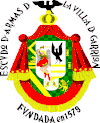Atlixco
| Atlixco | ||
|---|---|---|
|
||
 |
||
| Location in Mexico | ||
| Coordinates: 18°54′N 98°27′W / 18.900°N 98.450°WCoordinates: 18°54′N 98°27′W / 18.900°N 98.450°W | ||
| Country |
|
|
| State | Puebla | |
| Founded | 1579 | |
| Municipal Status | 1706 | |
| Government | ||
| • Municipal President | Ricardo Camacho Corripio | |
| Area | ||
| • Municipality | 229.22 km2 (88.50 sq mi) | |
| Elevation (of seat) | 1,035 m (3,396 ft) | |
| Population (2008) Municipality | ||
| • Municipality | 125,000 | |
| • Seat density | 1,035/km2 (2,680/sq mi) | |
| Time zone | CST (UTC-6) | |
| Postal code (of seat) | 21019 | |
| Area code(s) | 33 | |
| Demonym | Atlixquense | |
| Website | (Spanish) Municipal Official Site | |
Atlixco (Nahuatl pronunciation: [aːˈt͡ɬiːʃko] is a city and a municipality in the Mexican state of Puebla. It is a regional industrial and commercial center but economically it is much better known for its production of ornamental plants and cut flowers. The city was founded early in the colonial period, originally under the jurisdiction of Huejotzingo, but eventually separated to become an independent municipality. The municipality has a number of notable cultural events, the most important of which is the El Huey Atlixcayotl, a modern adaptation of an old indigenous celebration. This event brings anywhere from 800 to 1,500 participants from all over the state of Puebla to create music, dance and other cultural and artistic performances.
The city of Atlixco is in the west of the state of Puebla at an elevation of 1,881 meters above sea level, twenty five km from the state capital of Puebla . The main economic activities of the city are agriculture and basic commerce. It lies at the foot of the Cerro de San Miguel mountain, which is the main geographical and cultural landmark, marked by a small hermitage at the top dedicated to the Archangel Michael. According to local lore, a demon was entrapped in the well there, after causing problems in the community. There are also lookout points that provide panoramic views of the city.
The city centers on a main square which is Moorish in style, surrounded by restaurants and other places selling local specialties and ice cream. Notable location on or near the square include the Casa de la Audencia, with its portal supported by Tuscan columns, the Portal Hidalgo, the old Marqués de Santa Martha House, the Botica Poblana farmacy, founded in 1877, (the farmacy was taken down about 2005 so it no longer exists) the Rascon Building from the late 19th century, CADAC an arts and trades school and the Isaac Ochotorena House from the 18th century. Another important area of the city is Colonia Cabrera, noted for its abundance greenhouse production of flowers and ornamental plants.
The most important churches in the city date from the 18th century, noted for their intricate “folk Baroque” facades created from stucco by indigenous craftsmen. The La Merced Temple is all that remains of a Mercedarian monastery. Most of the church, including a decorative side door is from the 17th century, but the façade is from the 18th century. The main portal is decorated with paired columns, spiraling vines in high relief and ornamental sculptures in niches on both the upper and lower levels. The doorway itself is a lobed Moorish arch. The center of this decoration is a niche with an image of the Virgin of Mercy, who shelters Mercedarian founder Pedro Nolasco and other saints with her cloak. The interior was redone in the 19th century, but maintains a large colonial era portrait of Our Lady of Mercy by José Joaquín Magón as well as an 18th-century inlaid wood pulpit. This church has a collection of paintings from the colonial period. This collection is under the care of the Adopt a Work of Art campaign working to restore many of the canvases to their original state.
...
Wikipedia


